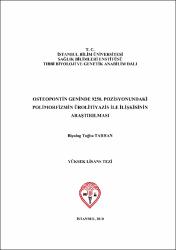Osteopontin geninde 9250. pozisyonundaki polimorfizmin ürolitiyazis ile ilişkisinin araştırılması
Künye
Tarhan, Tuğba. (2010). Osteopontin Geninde 9250. Pozisyonundaki Polimorfizmin Ürolitiyazis İle İlişkisinin Araştırılması. Yayımlanmamış yüksek lisans tezi. İstanbul : İstanbul Bilim Üniversitesi, Sağlık Bilimleri Enstitüsü.Özet
Osteopontin (OPN) (bone sialoprotein 1 (BSP1), early T-lymphocyte activation 1 (Eta-1), secreted phosphoprotein 1 (SPP1) ) kemik, böbrek gibi çeşitli dokularda ve aynı zamanda T lenfositler, makrofajlar, endotel hücreleri, düz kas hücreleri, epitel hücreleri gibi farklı birçok hücre tipinde eksprese olur. OPN, mültipl skleroz (MS), sistemik lupus eritematozus (SLE), romatoid artrit (RA) gibi otoimmun hastalıklar ve Crohn hastalığı, obezite, kardiyovasküler hastalıklar, böbrek hasarı gibi kronik inflamasyon ile karakterize olan hastalıklar ve çeşitli kanser tiplerinde önemli rol oynamaktadır. OPN rs1126616 polimorfizminin ürolitiyazis, primer biliyer siroz (PBC) ve SLE ile ilişkisi çeşitli çalışmalarda gösterilmiştir. Ayrıca OPN genindeki diğer tek nükleotit polimorfizmlerinin (SNP) taş hastalığı üzerindeki etkileri ile ilgili çeşitli çalışmalar bulunmaktadır.
Bu çalışmadaki amacımız, 64 ürolitiyazis hastası ve aile öyküsünde taş hastalığı olmayan 50 sağlıklı kontrolde OPN geni rs1126616 polimorfizminin taş oluşumu üzerindeki etkisini araştırmaktır. X ışını difraksiyon (XRD) yöntemi ile taş analizleri yapılan 62 kalsiyum oksalat ve 2 adet strüvit taş hastası toplamda 64 adet ürolitiyazis tanısı konmuş hasta ile aile öyküsünde taş hastalığı bulunmayan 50 adet sağlıklı kontrolde OPN rs1126616 polimorfizminin sıklığı araştırıldı. Genotipleme, polimorfik bölgenin polimeraz zincir reaksiyonu (PZR) ile çoğaltılmasının ardından restriksiyon uzunluk parça polimorfizmi (RFLP) yöntemi kullanılarak yapıldı.
Ürolitiyazis hastalarında OPN genine ait CC, CT ve TT genotip frekansları sırasıyla; %37.5, %43.7 ve %18.7; kontrol grubunda ise %80, %4 ve %16; hasta grubunda en az bir mutant T alleli taşıma sıklığı % 62.5 iken kontrol grubunda %20 olarak bulundu. Hasta ve kontrol grubu vücut kitle indekslerine (VKĠ) göre 25 kg/m2‘den küçük (VKĠ<25 kg/m2) ve 25 kg/m2‘ den büyük (VKĠ>25 kg/m2) olmak üzere sınıflandırıldığında, VKĠ>25 kg/m2 olan ürolitiyazis hastalarında en az bir mutant T alleli taşıma sıklığı %66.7 iken VKĠ>25 kg/m2 olan sağlıklı kontrollerin tamamı yabanıl tip (CC) olarak bulundu.
Sonuç olarak Türk popülasyonundaki taş hastalarının OPN rs1126616 polimorfizmini taşıma sıklığının yüksek olması ürolitiyaziste OPN‘nin önemli rol oynayabileceğini göstermektedir. Ayrıca fazla tartılı ürolitiyazis hastalarında bu polimorfizmin görülme sıklığının yüksek olması, ürolitiyazis ile obezite arasında bir ilişki olabileceğini akla getirmektedir. Osteopontin (OPN) (bone sialoprotein 1 (BSP1), early T lymphocyte activation 1
(Eta-1), secreted phosphoprotein 1 (SPP1) ) is found to be expressed various tissues
including bone, kidney and in also T lymphocytes, macrophages, endothelial cells, smooth
muscle cells and epithelial cells. OPN has an important role in various disorders as such;
autoimmune disorders such as multiple sclerosis (MS), sistemic lupus erythematosus
(SLE), rheumatoid arthrit (RA); characterized chronic inflammation related diseases e.g;
Crohn disease, obesity, cardiovascular disease and renal injury and in various cancer types.
Recent studies shows that OPN rs1126616 polymorphism is associated with urolithiasis,
primary biliary sclerosis (PBC) and SLE. In the literature, other defined SNP‘s in OPN
gene have also been investigated in order to define their role in urolithiasis.
The aim of our study was to investigate OPN rs1126616 polymorphism in 64
urolithiasis patients together with 50 healthy controls having no history of kidney stone in
their families. Stones were analyzed for chemical composition by the use of X-Ray
diffraction method. The analysis revealed that 62 of our patients were having calcium
oxalate (CaOx) stone and only 2 struvite stone. The study groups were genotyped by using
PCR-RFLP method.
In urolithiasis patients the genotype frequencies for OPN rs1126616 revealed the
following results; CC, 37.5%; CT, 43.7%; TT, 18.7% and in control group the results were
as follows; CC, 80%; CT, 4%; TT, 16%. In patient group the frequency of carrying at least
one mutant T allele was found to be 62.5% and in control group 20%. The patient and
control groups were also analyzed according to their body mass index (BMI). The groups
were classified regarding to their BMI being bigger than or smaller than 25 kg/m2. The
results showed that 66.7% of patients with BMI>25 kg/m2 were carrying at least one
mutant T allele wheras the healthy controls with BMI>25 kg/m2 were all having CC
(wildtype).
Our results showed that OPN rs1126616 polymorphism is found to be significantly
higher in Turkish urolithiasis patients. These results might be indicating the important role
of OPN in urolithiasis. Our urolithiasis patients having BMI>25 kg/m2 clearly showed that
they are carrying at least one polymorphic allele. Interestingly, the link between
urolithiasis and obesity need to be further studied in our population.


















